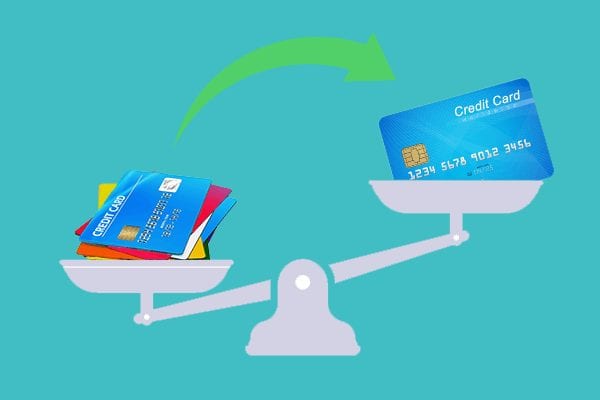When it comes to managing credit card debt, many people think of balance transfers as a last resort. However, you don’t have to be struggling to benefit from this financial strategy. In fact, carrying debt on a credit card is often expensive, even if you’re making your payments every month without fail. If you can save money in the long run through a balance transfer, it’s definitely worth considering alongside credit card debt forgiveness. Let’s explore what a balance transfer is, how it works, and whether it might be the right move for you.
What is a Balance Transfer?
A balance transfer is when you move your existing credit card debt from one card to another, typically to take advantage of a lower interest rate. Many credit card companies offer promotional rates, often at 0% for a certain period, which can help you save money on interest payments.
Example of a Balance Transfer
Let’s say you have a credit card with a balance of $5,000 at an interest rate of 20%. If you only make the minimum payments, it could take you years to pay off that debt—and you’d end up paying a significant amount in interest. However, if you transfer that balance to a card offering 0% interest for 12 months, you could save a considerable amount in interest during that time, allowing more of your payment to go toward the principal balance.
Who Can Benefit from a Balance Transfer?
While balance transfers are often associated with those struggling to pay off debt, they can actually be beneficial for anyone carrying credit card balances. Here’s why:
Lower Interest Rates: As mentioned, many balance transfer offers come with lower interest rates. This means you’ll pay less in interest, freeing up more money to put toward paying down your debt.
Simplified Payments: If you have multiple credit cards with varying balances and due dates, consolidating them into one balance transfer can simplify your monthly payments. This makes it easier to manage your finances and avoid missed payments.
Credit Card Debt Forgiveness: While balance transfers themselves aren’t a form of debt forgiveness, they can help you manage your debt more effectively. By reducing the interest you pay, you effectively “forgive” a portion of the debt’s cost over time.
Understanding the Costs and Considerations
Before diving into a balance transfer, it’s essential to consider the potential costs and factors involved:
1. Balance Transfer Fees
Many credit card companies charge a balance transfer fee, which is typically around 3-5% of the amount transferred. This fee can eat into your potential savings, so be sure to calculate whether the transfer is still worth it after considering this cost.
2. Promotional Periods
Balance transfers often come with promotional interest rates that expire after a set period (usually 6-18 months). If you haven’t paid off the balance by the end of that period, the interest rate may jump to a higher standard rate, which can negate the savings you initially gained.
3. Impact on Credit Score
Applying for a new credit card for a balance transfer can temporarily impact your credit score due to a hard inquiry. However, if managed wisely, a balance transfer can ultimately improve your credit score by reducing your overall credit utilization ratio, especially if you pay down the debt aggressively.
Steps to Take Before Doing a Balance Transfer
If you decide a balance transfer might be right for you, here are some steps to ensure you’re making a wise financial decision:
1. Review Your Current Debt Situation
Start by taking a close look at your current debts. List out your credit card balances, interest rates, and minimum monthly payments. This will give you a clear picture of what you’re working with and help you determine whether a balance transfer makes sense.
2. Research Balance Transfer Offers
Look for credit cards that offer balance transfer promotions. Pay attention to the interest rates, promotional periods, and any associated fees. Some cards may have better offers than others, so it’s worth shopping around.
3. Calculate the Potential Savings
Before making a transfer, calculate how much you could save in interest. Compare your current interest costs with the potential costs after the transfer, factoring in any fees. If the savings are significant, it’s likely worth pursuing.
4. Read the Fine Print
Make sure to thoroughly read the terms and conditions of the balance transfer offer. Understanding the details, including the expiration of the promotional rate and the penalty for missed payments, is essential to avoid surprises later.
Managing Your Debt After a Balance Transfer
Once you’ve completed a balance transfer, it’s crucial to stay on top of your finances to maximize the benefits:
1. Create a Repayment Plan
Set a clear repayment plan to pay off the transferred balance before the promotional interest rate expires. Determine how much you need to pay each month to reach your goal. This will help you stay focused and avoid falling back into debt.
2. Avoid Accumulating New Debt
After transferring your balance, resist the temptation to charge more on your credit cards. Creating a budget can help you track your spending and avoid accumulating new debt while you work on paying off your existing balance.
3. Monitor Your Progress
Regularly check your statements and track your progress. Celebrate small milestones to stay motivated—every payment brings you closer to being debt-free!
Conclusion: Making Informed Choices
Deciding whether a balance transfer is right for you involves weighing the benefits against the costs. By understanding how balance transfers work and taking the necessary steps, you can effectively manage your debt and potentially save a significant amount in interest. Whether you’re looking to simplify your finances or find relief from high interest, a balance transfer could be a smart move. Stay informed, create a plan, and take control of your financial future!
Keep an eye for more latest news & updates on Vents Breaking!

